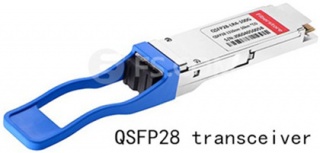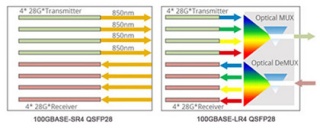Marketing
Why Choose QSFP28 Transceivers for 100G Transmission?
Over the years, there has been an unprecedented increase in network connectivity and bandwidth needed to accommodate workload requirements of cloud computing, and high-performance web services. The rapid advancements in fiber optic technology has enabled easy upgrading from 10GbE to 40/100GbE within the data centers. With the emergence of 100GbE technologies, the creation of data center network architectures free from bandwidth constraints has been made possible. Among 100G interconnect components, QSFP28 transceiver is the predominant form factor for 100G switching and routing connectivity, a key enabler as 100G begins to ramp in data centers.
QSFP28 Brief Introduction
QSFP28 is the exact same footprint as the 40G QSFP+ module, “Q” for “Quad”. Just as the 40G QSFP+ is implemented using four 10-Gbps lanes, the 100G QSFP28 is implemented with four 25-Gbps lanes. In all QSFP versions, both the electrical lanes and the optical lanes operate at the same speed, eliminating the costly gearbox found in CFP, CFP2, and the CPAK. The QSFP28 module has an upgraded electrical interface to support signaling up to 28Gbps signals, yet keeps all of the physical dimensions of its predecessor. As QSFP28 technology becomes even maturer, QSFP28 transceivers become more and more popular in 100G optics market.
There are mainly two 100G QSFP28 transceiver versions: 100GBASE-SR4 QSFP28 transceiver and 100GBASE-LR4 QSFP28 transceiver. The former is specified to operate over multi-mode fiber (MMF) with the maximum link length of 70m on OM3 and 100m on OM4, while QSFP28 100GBASE-LR4 is standardized to work through single-mode fiber (SMF), able to realize 10km link length. The image below shows the working principles of 100GBASE-SR4 QSFP28 (left) and 100GBASE-LR4 QSFP28(right).
Why Choose QSFP28 Transceiver?
Since its surge, the QSFP28 transceiver has gained increasing popularity among enterprises or organizations, as it increases density and decreases power and price per bit. 100G QSFP28 makes it as easy to deploy 100G networks as 10G networks. Listed below are specific reasons why choose QSFP28 for 100G transmission?
At the first point, QSFP28 increases front-panel density by 250% over QSFP+. Although QSFP28 has the same form factor and the maximum number of ports as QSFP+ module, the lane speeds are increased from 10Gbps to 25Gbps.
Next, QSFP28 breaks some limitations found in other 100G optics. For instance, in the first generation of 100G switches and routers, the smaller CXP form factor was used for cabling and the CFP or CFP2 was used for transceivers. This forced the equipment designer to make huge sacrifices. Besides, a switch with CXP port could not be used in any data center with SMF, and a router with CFP2 or CPAK ports was limited in bandwidth by the 8-10 ports that could fit on the front panel. Well, as for QSFP28, it’s designed to support both cables and transceivers. Within QSFP28, a 1 rack-unit (RU) switch can accommodate up to 36 QSFP ports on the front face plate. Many varieties of either transceivers or cables can plug into these ports. The cables can be either direct attach cables (DACs), commonly referred to as direct attach copper cables, or active optical cables (AOCs).
Finally, QSFP28 transceivers can use either VCSELs (for shorter distances on MMF) or silicon photonics (for longer distances on SMF). The advent of silicon photonics enables QSFP28 transceivers to support any data center reach up to 2km or more. Silicon photonics provides a high degree of integration; the CMOS chips are small enough to fit within a QSFP package. Silicon photonics is low-power; even WDM designs can fit within the 3.5W maximum of QSFP.
Conclusion
With the fiber optic technology becoming maturer and more available, the choice of high-bandwidth switches, routers, and adapters which feature QSFP28 will be diversified, ensuring data centers to scale to 100G networks with the simplicity as 10G networks. Fiberstore supplies a large number of QSFP28 transceivers available in QSFP28 100GBASE-SR4 and QSFP28 100GBASE-LR4 types. If you want to know more information about QSFP28 transceivers, you can visit Fiberstore.
Post je objavljen 18.05.2016. u 05:16 sati.

